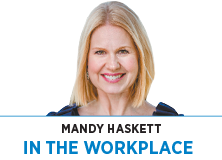Subscriber Benefit
As a subscriber you can listen to articles at work, in the car, or while you work out. Subscribe Now I consulted recently with a group of leaders weighed down by events of the past 18 months—a failed product launch, lost funding and the resignation of three key leaders. Company officers dissected what happened. They diagnosed possible causes. Then they got stuck.
I consulted recently with a group of leaders weighed down by events of the past 18 months—a failed product launch, lost funding and the resignation of three key leaders. Company officers dissected what happened. They diagnosed possible causes. Then they got stuck.
This team had a strategy in place, and members were being held accountable to certain results. But what sits between every organization’s strategy and its results are its people. And the people out of alignment in this story were the leaders.
They were misaligned on which approach would lead to the greatest success, and some were misaligned with the behaviors that would drive the intended results altogether.
At best, this type of misalignment leads to confusion, frustration and decreased productivity. At worst, this group faced the prospect of even more turnover, lower engagement, and lost time and money.
Having just met them, I encouraged: “It’s not what happened. It’s what happens next.”
This phrase comes to mind for me when tackling problems of all sizes: spiriting my children through their math quizzes, mending hurt feelings, recovering from an injury, or dealing with a missed deadline or a missed opportunity.
By now, we know that great leadership isn’t about perfection. It’s about self-awareness. And we know objective human data is the gateway to developing that awareness—the No. 1 most critical competency among leaders.
Just like people, businesses need self-awareness, too.
And they need objective tools to access it. This means measuring your leaders against your strategy before you commit to its results. Paramount to your success is ensuring your leaders are aligned on what the strategy is, in agreement on their confidence level before execution, and understand how they are hardwired as humans to individually gravitate toward and reject particular strategies.
Organizations can employ four unique types of strategies: cultivating, exploring, producing and stabilizing. These methodologies each have different constructs and constraints that challenge execution.
Think about your business. Which of these strategies describes yours?
A cultivating strategy is focused on the commitment, loyalty and morale of the employees. Structure and processes are accommodating and predictable for the team. The goal is focused on team cohesion, and success is defined by engagement, internal culture and employee opinion.
If this sounds like you, ask yourself: Are we supportive, transparent and empathetic to the needs of our people?
An exploring strategy is focused on innovation and new opportunities. It’s nimble, flexible and able to drive many directions at once. Structures and processes are decentralized and easily adaptable with lots of entrepreneurial goals. Success is measured by products and services unique to the market.
If this sounds like you, ask yourself: Are we visionary, innovative and comfortable with taking risks? Do our leaders inspire action and cultivate creativity?
A producing strategy is focused on finding new clients and building a reputation. It’s competitive and often uses pricing, quality and delivery tactics to win. Structures and processes help maintain control and consistency across teams and outputs. Success is defined by market share and penetration.
If this sounds like you, ask yourself: Are we driving, competitive and disciplined with rules? Are leaders clearly articulating expectations of employees and coaching them to success?
A stabilizing strategy is focused on continual improvement, efficiency and predictability of services. It’s always looking to ways to simplify and improve. Structures and processes are standardized and automated to minimize risk, improve scalability and decrease costs. Success is defined by higher performance to ensure customer loyalty.
If this sounds like you, ask yourself: Are we organized, coordinated and efficient, following rules and processes to mitigate risk? Have our leaders created an environment of fairness and stability?
After briefly explaining each type, light bulbs began to illuminate for my client. They had joined the team a decade ago to cultivate and stabilize. Each person was socially oriented, methodical and hardwired to make decisions carefully and cautiously.
Now leaders in the business, these same individuals saw the need to lead the company in an exploring direction. But the risk-seeking, fast-paced behavior this approach requires didn’t feel in line with who they were as people or as a culture. And with no data to illuminate the problem, they experienced the backfire.
Fueling this phenomenon is the truism that we humans will all behave in ways to get our own inherent motivating needs met. And that means we will all eventually turn our jobs into ourselves—doing the things that give us energy and procrastinating the things that don’t meet our needs.
Using a tool like the PI Strategy Assessment would have saved my client 18 months of “learning the hard way.”
Reflect on your own business again. How do you know your leaders will carry out your strategy? And what will happen next?•
__________
Haskett is a leadership consultant at Advisa, a Carmel-based leadership consultancy.
Please enable JavaScript to view this content.
